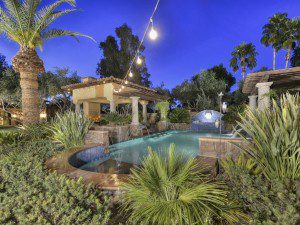 By Joe Szabo, Scottsdale Real Estate Team
Early-career home buyers tend to be light on cash, while mid-career home buyers are saving for retirement, and retiree home buyers are facing less income. Each of these life phases requires a different mortgage strategy. Here are some planning tips to help you make smart decisions, no matter where you are in life.
By Joe Szabo, Scottsdale Real Estate Team
Early-career home buyers tend to be light on cash, while mid-career home buyers are saving for retirement, and retiree home buyers are facing less income. Each of these life phases requires a different mortgage strategy. Here are some planning tips to help you make smart decisions, no matter where you are in life.
Planning basics
There are three main considerations in mortgage planning:- Cash to close. Most home loans require a down payment, which can range from 3 percent to 20 percent of a home’s purchase price. In addition, a home purchase will also have closing costs, which can range from 1 percent to 3 percent of a home’s purchase price, and will cover lender fees, title/escrow fees, and various property taxes that vary by county.
- Monthly cost. When you rent a home, you have a rental payment plus certain utility bills that your landlord doesn’t pay. When you’re a homeowner, you have a mortgage payment (comprised of interest and monthly pay-down on your loan), property taxes, insurance, all utility bills, and maintenance — plus mortgage insurance and condo homeowners association dues, if applicable. On top of this, you should also be saving a certain amount per month for longer-term maintenance and repairs as your home ages.
- Home equity. The percentage of your home’s value that isn’t financed is called equity, and your equity can grow in two ways: by paying your loan down, or by your home increasing in value. Equity is the part of homeownership where your wealth can grow over time.
Millennials: finding the down payment
Millennial home buyers haven’t been in the workforce that long, so cash to close is often the primary consideration for them. A 20-percent down payment means you’ll avoid extra costs like a second mortgage or mortgage insurance. However, if you’re a younger buyer who hasn’t saved 20 percent yet — and you don’t want to postpone the benefits of homeownership while you save — don’t worry: your down payment can be as low as 3 percent. On a $300,000 home purchase, a 3-percent down payment is $9,000, and a 20-percent down payment is $60,000. The tradeoff comes in monthly payment. If you go with the $9,000 down payment, your monthly payment using a 30-year fixed rate of 3.5 percent will be about $1,911. This includes your mortgage payment, property taxes, insurance, and mortgage insurance. The $60,000 down payment scenario gives you a $1,444 payment. Putting 3 percent down costs $467 more per month, but requires $51,000 less down payment. When figuring out your optimal down payment with your mortgage advisor, don’t forget that closing costs of 1 percent to 3 percent on a $300,000 purchase price will be $3,000 to $9,000 on top of down payment.Gen Xers: balancing spending and saving
Gen X home buyers are mid-career, and monthly costs are often their primary consideration as they save for retirement and their kids’ college expenses. On our $300,000 purchase price example, Gen Xers’ big decision could be the same as the millennial decision: do you choose to pay $467 more per month to save $51,000 in down payment? If you did, we know you’d have a monthly cost of $1,911, excluding maintenance and utilities, for a $300,000 home with 3 percent down. We also know that your property taxes and mortgage interest are tax deductible, and this would result in an after-tax monthly housing cost of about $1,566. Now we need to compare $1,566 in after-tax housing cost to what it would cost to rent a home of the same quality in the same area. If it’s about the same to rent vs. buy, then you have a good scenario to conserve cash and be a homeowner. Your mortgage and financial advisers can run different down payment scenarios to optimize the balance between monthly cost and cash preservation.Baby boomers: living on less
Because baby boomer home buyers are late-career or retired, living on less income is often their primary consideration. If you’re a baby boomer with equity in your home but less income-generating savings than you planned for, you have a few options to sort through with your mortgage adviser:- Get a reverse mortgage that allows you to convert a portion of the equity in your home into cash to live on.
- Get a home equity loan to obtain cash from your home — but this is a traditional loan that comes with a monthly payment.
- Sell your home to buy or rent a cheaper home and get cash.



